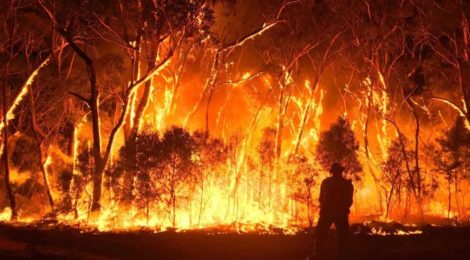
Australia Deadly Fires Emit 300 Million Tonnes Of Climate Changing CO2
Mother Natures Red Dust Miracle Comes To Australia’s And The Worlds Rescue
Massive Australian Dust Storm Approaching The Size Of The 2009 Dust Storm Is Sweeping Millions Of Tonnes Of Red Iron Rich Dust Out To Sea
That vital dust will replenish vital minerals to the ocean pastures bringing them back to life
Restored ocean life will repurpose millions of tonnes of CO2 it scrubs from the air into new ocean life
Since September, hundreds of fires across Australia have torched more than 6.3 million hectares of land. Homes and even villages have been incinerated and 25 people killed so far. The fires followed months of hot, dry weather and with strong winds, the perfectly deadly firestorm conditions emerged. There were at least twice as many fires in New South Wales in 2019 as there were in any other year this century.
The fires are estimated to have released more than 300 million tonnes of CO2 from the burning forests and grasses. That’s more than half of Australia’s national ‘carbon footprint.’ It’s an unusually large fire season but not an uncommon one.
Today a ferocious dust storm is blanketing eastern Australia. Many fear this is a second massive blow by Mother Nature damaging the Australian environment. But in reality, this is Mother Nature doing what she does best balancing the horror and harm of the fires with the blessing of the dust. The red iron-rich dust as it blows out to sea will restore the ocean pasture plankton blooms that will feast on both the dust and the fires CO2.
Dust for the oceans restores the plankton blooms, silver fish, ocean life, it thrives it even booms.
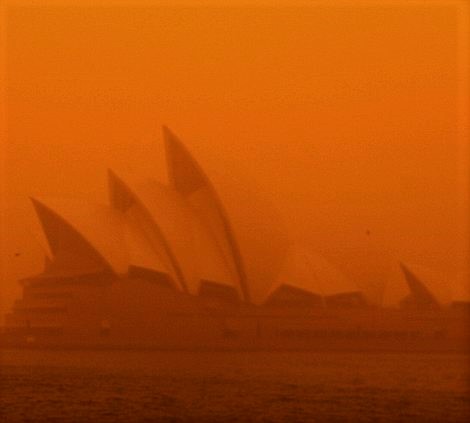
Sydney’s iconic Opera House on September 23, 2009. A huge outback dust storm swept eastern Australia. Everything came to a halt as millions of tonnes of iron-rich red dust covered thousands of kilometers.
The Australia dust storm season of spring 2009 was particularly active. On September 22 Sydney awoke to a “Red Dawn”. The storm continued into the following day.
The dust from this storm likely originated in the southern Lake Eyre Basin in central Australia, in South Australia and in western and central New South Wales. It was the largest dust storm (in terms of visibility reduction) to pass over Sydney since records began in 1940.
During and prior to the “Red Dawn” event, winds of 80-100km/h were recorded in the western part of NSW, and elevated dust was recorded at numerous Dustwatch stations across New South Wales on September 22 and 23. The storm affected visibility in Brisbane and as far north as Cairns.
An estimated 2.5 million tonnes of sediment was lost off the Australian coast in a 3,000-kilometre-long dust plume, making it the largest loss of soil from the Australian continent ever reported.
Research shows the two dust storms that traversed the south-east coast of Australia caused a widespread spike in phytoplankton biomass in the Tasman Sea. This was especially so south of the Tasman Front (at around 32 degrees south), where the East Australian Current veers east from the Australian coastline.
Interestingly, although the “Red Dawn” event of late September was one of the largest on record in terms of total soil loss, the biological response was almost as strong following the less intense mid-October event. This suggests the timing and mode of delivery of dust-derived nutrients are critical.
A previous 20-year study of dust storms suggested that it is unusual for dust storms to happen at the right time to cause plankton blooms.
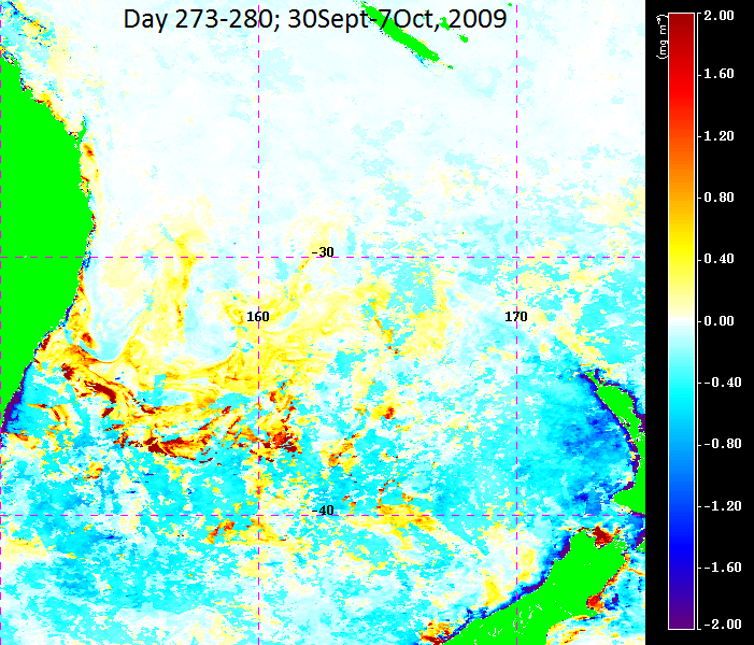
Satellite data of Tasman Sea Chlorophyll following Sidney’s Red Dawn. Perhaps as much as 100 million tonnes of CO2 was drawn into ocean pastures which in turn provided a fabulously healthy fish and ocean life feeding station for many months.
Chlorophyll is the material that allows plant cells to convert sunlight into energy, thus enabling them to grow. It’s a green substance and thus a good indicator of overall plant health: robust forests, lush lawns and vibrant phytoplankton blooms appear green.
Chlorophyll concentration at the ocean surface is a proxy for phytoplankton biomass, and can be estimated using satellite-based ocean colour sensors (such as NASA’s MODIS Aqua).
During the spring of 2009 chlorophyll was far above the long-term climatological mean for the southern spring (0.3-0.4 milligrams per cubic metre). Values were more than double normal concentrations.
(Ref: A. J. Gabric, R. Cropp, G. McTainsh, H. Butler, B. M. Johnston, T. O’Loingsigh, Dien Van Tran. Tasman Sea biological response to dust storm events during the austral spring of 2009. Marine and Freshwater Research, 2015; DOI: 10.1071/MF14321 – Linked here)
Many ocean science studies of the Tasman show it receives less dust than it needs and thus its phytoplankton growth is highly limited. From time to time Mother Nature comes to the rescue.
We can and we must restore the worlds ocean pastures
Some years ago I toured across South Australia on a Four Masted Clipper ship, the Stad Amsterdam. The ship was retracing Charles Darwin’s Voyage of the Beagle and I was invited aboard to participate in satellite television broadcasts to describe how dust from the lands of the world has been decreasing, how this drought of dust was turning formerly lush blue-green ocean pastures into clear blue lifeless deserts.
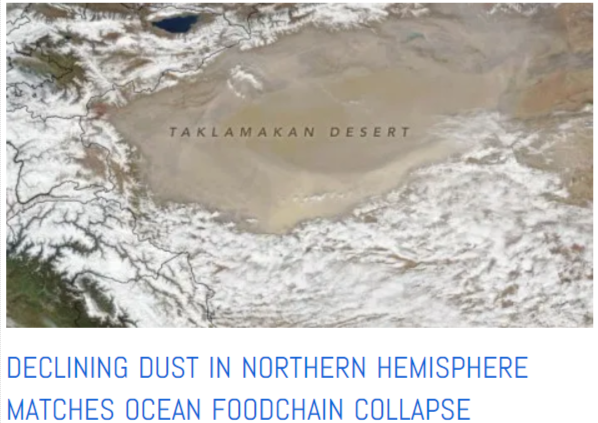
NASA reports Jan 2020, dust decline in Northern Hemisphere is starving the ocean food chain. Click to read more
30+ years of dedicated ocean pasture research performed by scores of ocean scientists at a cost of half a billion dollars in research funding has proven that the ocean is dying for want of dust that human CO2 has been keeping from the oceans. Just this past week a major paper by NASA has shown that dust blowing out of China and Mongolia has been observed to be in dramatic decline for decades.
We must restore the ocean’s dust, we can’t depend on Mother Nature to do all the work to clean up our chaos.
How To Bring Back Billions Of Fish, Feed The World’s Hungry – Ocean Pasture Restoration Repurposes Billions Of Tonnes Of CO2 Into Ocean Life

North Pacific Currents Define Salmon Habitat. The Green Pasture Patch Is Our 2012 Restored Ocean Pasture. It’s the most vital salmon nursery where most of the baby salmon from go to put on 95% of their adult body weight. (blue paths show their migratory routes.)
In 2012 after many years of development work my public private partnership of my company, a native peoples village, the provincial government of British Columbia and the Federal government of Canada completed a commercial-scale pilot project designed to restore and replenish a vital ocean salmon pasture in the N.E. Pacific. I provided the proprietary technology, methodology, scientific and engineering expertise, the tiny Haida village of 800 residents provided $2 million dollars and their heart and soul, and government ministries and national research councils provided large R&D grants, sovereign loan guarantees, and all manner of assistance and rigorous oversight.
It’s well established that salmon from the rivers and streams of the West Coast of North America must make their way to the Alaskan Gyre where water temperatures and the ecology are matched to salmon biology. There on the ocean pastures, those salmon will put on more than 95% of their body weight in the 2-4 years before the urge to return to spawn. A key element in the project design was that I selected the location and timing for the work so that it would coincide with the migratory behavior of young salmon from SE Alaska, Canada, and the Pacific Northwest.
They reach the gyre as babies so it is an all-important nursery for them. If the salmon were to go south of the North Pacific Current they would be swept into regions of the Pacific where the water is far too warm for them and which is filled with voracious predatory fish. Survival there is very unlikely.
I knew that the billions of baby salmon from this region that swim out the sea each year have been mostly starving and dying at sea and not coming home to us hale and hearty. The reason has been clear that they are dying because their vital ocean nursery pasture has been collapsing and not growing sufficiently to sustain the abundance of salmon it once did.
Pasture Restoration
If we could restore and replenish their vital nursery pasture the baby salmon would survive and thrive. Mother Nature had already shown us this worked when she dusted the region with mineral-rich volcanic ash from the Kasatochi Volcano in August of 2008. The blooms that followed made it clear that this part of the world’s ocean are deprived of vital mineral micronutrients.
Even though the massively revived volcanic plankton blooms of 2008 were late in the season two years later the salmon came back in historic abundance, especially to the Fraser River which is the last major run of salmon to reach the Alaskan Gyre.
The Kasatochi volcano was not unique, two other volcanic eruptions of Aleutian volcanoes had similarly produced record sockeye salmon returns to the Fraser River.
Associated with those volcano miracle plankton blooms were countless records of desperately poor years for Fraser sockeye with matching poor ocean pasture conditions.
In my experimental design, I knew I could not produce an effect that would compare in size to the volcano. But we could be smarter than a dumb volcano. I could prescribe and administer exactly the right mineral micronutrients in exactly the right place at exactly the right time. All it would take would be me and 11 shipmates on one solitary fishing boat with a load of iron-bearing mineral dust.
What results have we seen.
Aside from the tens of thousands of oceanographic samples that were collected before, during, and after the primary at sea ocean pasture restoration more than a hundred thousand discrete measurements were made of our pasture and the surrounding ocean.
When the salmon who lived in our restored and revived ocean pasture started swimming home in the fall of 2013 we were overwhelmed with reports of their numbers. Hundreds of millions of additional salmon over and above the numbers predicted by conventional fisheries science swam back to us with a second treasure trove of delicious data.
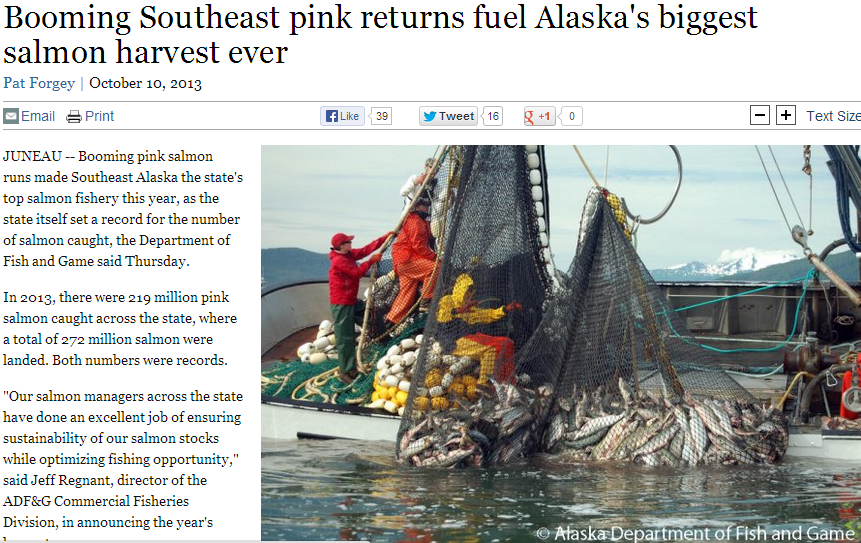
My 2012 ocean pasture replenishment and restoration work in the NE Pacific returned the ocean to life as seen in the largest catch of salmon in all of history in Alaska the next year. Click to enlarge
The SE Alaska Pink catch in the fall of 2013 was a stunning 226.3 million fish. This when a high number of 50 million fish were expected. Those extra ocean pasture fed fish came back because their pasture was enjoying the richest plankton blooms ever, thanks to me a 11 shipmates and our work in the summer of 2012.
IT JUST WORKS











